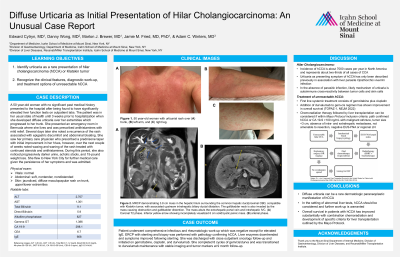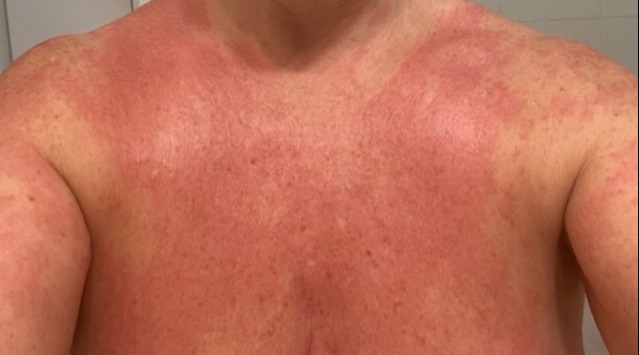Sunday Poster Session
Category: Biliary/Pancreas
P0072 - Diffuse Urticaria as Initial Presentation of Hilar Cholangiocarcinoma
Sunday, October 22, 2023
3:30 PM - 7:00 PM PT
Location: Exhibit Hall

Has Audio
- EC
Edward Cytryn, MD
Icahn School of Medicine at Mount Sinai
New York, New York
Presenting Author(s)
Edward Cytryn, MD, Danny Wong, MD, Marlon J. Brewer, MD, Jamie M. Fried, MD, PhD, Adam C. Winters, MD
Icahn School of Medicine at Mount Sinai, New York, NY
Introduction: Hilar cholangiocarcinoma (hCCA), or Klatskin tumor, is the most common form of cholangiocarcinoma. It is insidious and often diagnosed at a late stage. Cutaneous paraneoplastic syndromes have been described in association with cholangiocarcinoma though they represent rare clinical presentations of the tumor.
Case Description/Methods: A 50-year-old woman with no past medical history presented to a local emergency room with three weeks of diffuse urticaria over her chest and arms. She was prescribed antihistamines with mild relief but several days later noted recurrence of the rash and pruritus associated with epigastric discomfort and abdominal bloating. She saw her primary care physician who prescribed steroids and over the next two weeks noted waxing and waning of the rash. During the same period, she reported progressively darker urine, acholic stools, and 15-pound weight loss. Labs revealed significantly elevated transaminases (ALT 2,707; AST 1,301 U/L), bilirubin (total 9.1; direct 5.9 mg/dL), alkaline phosphatase (827 U/L), and gamma GT (1,386 U/L) and she was admitted to the hospital. Comprehensive infectious and rheumatologic work-up was negative except for a high IgE level (668 kU/L). She was found to have an elevated CA 19-9 (298.1 U/mL) and subsequently underwent an MRCP which showed a 3.8 cm mass in the hepatic hilum surrounding the common hepatic duct consistent with a Klatskin tumor. Additional CT imaging showed bilateral 6 cm heterogeneous ovarian masses concerning for metastatic disease. ERCP with stenting and biopsy confirmed hilar cholangiocarcinoma. The patient was discharged with close outpatient oncology follow-up and began chemotherapy promptly with response in tumor burden and resolution of her original rash.
Discussion: Patients with hCCA typically present later in the disease course with symptoms related to biliary obstruction. However, hCCA can be associated with myriad dermatologic paraneoplastic syndromes including subacute cutaneous lupus erythematosus and persistent erythema multiforme. Urticaria as a presenting symptom has been described previously in association with Opisthorchis viverrini. In the absence of a parasitic infection, it is thought that autoimmune cross-reactivity between tumor and skin cells accounts for these manifestations. Though difficult to diagnose early, overall survival in patients with hCCA has improved substantially with combination chemoradiation and development of specific criteria for liver transplantation outlined by the Mayo protocol.

Disclosures:
Edward Cytryn, MD, Danny Wong, MD, Marlon J. Brewer, MD, Jamie M. Fried, MD, PhD, Adam C. Winters, MD. P0072 - Diffuse Urticaria as Initial Presentation of Hilar Cholangiocarcinoma, ACG 2023 Annual Scientific Meeting Abstracts. Vancouver, BC, Canada: American College of Gastroenterology.
Icahn School of Medicine at Mount Sinai, New York, NY
Introduction: Hilar cholangiocarcinoma (hCCA), or Klatskin tumor, is the most common form of cholangiocarcinoma. It is insidious and often diagnosed at a late stage. Cutaneous paraneoplastic syndromes have been described in association with cholangiocarcinoma though they represent rare clinical presentations of the tumor.
Case Description/Methods: A 50-year-old woman with no past medical history presented to a local emergency room with three weeks of diffuse urticaria over her chest and arms. She was prescribed antihistamines with mild relief but several days later noted recurrence of the rash and pruritus associated with epigastric discomfort and abdominal bloating. She saw her primary care physician who prescribed steroids and over the next two weeks noted waxing and waning of the rash. During the same period, she reported progressively darker urine, acholic stools, and 15-pound weight loss. Labs revealed significantly elevated transaminases (ALT 2,707; AST 1,301 U/L), bilirubin (total 9.1; direct 5.9 mg/dL), alkaline phosphatase (827 U/L), and gamma GT (1,386 U/L) and she was admitted to the hospital. Comprehensive infectious and rheumatologic work-up was negative except for a high IgE level (668 kU/L). She was found to have an elevated CA 19-9 (298.1 U/mL) and subsequently underwent an MRCP which showed a 3.8 cm mass in the hepatic hilum surrounding the common hepatic duct consistent with a Klatskin tumor. Additional CT imaging showed bilateral 6 cm heterogeneous ovarian masses concerning for metastatic disease. ERCP with stenting and biopsy confirmed hilar cholangiocarcinoma. The patient was discharged with close outpatient oncology follow-up and began chemotherapy promptly with response in tumor burden and resolution of her original rash.
Discussion: Patients with hCCA typically present later in the disease course with symptoms related to biliary obstruction. However, hCCA can be associated with myriad dermatologic paraneoplastic syndromes including subacute cutaneous lupus erythematosus and persistent erythema multiforme. Urticaria as a presenting symptom has been described previously in association with Opisthorchis viverrini. In the absence of a parasitic infection, it is thought that autoimmune cross-reactivity between tumor and skin cells accounts for these manifestations. Though difficult to diagnose early, overall survival in patients with hCCA has improved substantially with combination chemoradiation and development of specific criteria for liver transplantation outlined by the Mayo protocol.

Figure: Patient with diffuse urticaria on chest and arms.
Disclosures:
Edward Cytryn: Exact Sciences – Grant/Research Support.
Danny Wong indicated no relevant financial relationships.
Marlon Brewer indicated no relevant financial relationships.
Jamie Fried indicated no relevant financial relationships.
Adam Winters indicated no relevant financial relationships.
Edward Cytryn, MD, Danny Wong, MD, Marlon J. Brewer, MD, Jamie M. Fried, MD, PhD, Adam C. Winters, MD. P0072 - Diffuse Urticaria as Initial Presentation of Hilar Cholangiocarcinoma, ACG 2023 Annual Scientific Meeting Abstracts. Vancouver, BC, Canada: American College of Gastroenterology.
